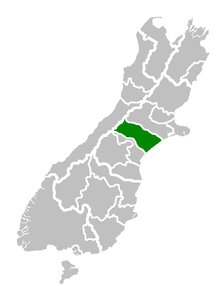Ashburton, New Zealand
Ashburton (Māori: Hakatere) is a large town in the Canterbury Region, on the east coast of the South Island of New Zealand. The town is the seat of the Ashburton District, a territorial authority encompassing the town and a number of small settlements within its surrounding rural area, roughly coterminous with the subregion of Mid Canterbury. It is 85 kilometres (53 mi) south west of Christchurch and is sometimes regarded as a satellite town of Christchurch.[4]
Ashburton Hakatere (Māori) | |
|---|---|
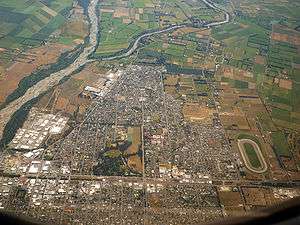 Aerial view of Ashburton, looking west. The Ashburton River/Hakatere is visible at left. | |
| Nickname(s): Ashvegas | |
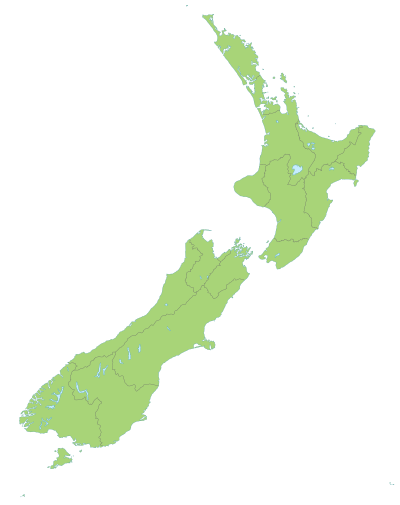 Ashburton Ashburton | |
| Coordinates: 43°54′20″S 171°44′44″E | |
| Country | |
| Region | Canterbury |
| District | Ashburton District Council |
| Wards | Ashburton Eastern Western |
| Electorates | Rangitata Te Tai Tonga (Maori electorate)[1] |
| Government | |
| • Mayor | Neil Brown |
| • Deputy Mayor | Liz McMillan |
| Area | |
| • Territorial | 6,187.40 km2 (2,388.97 sq mi) |
| Population (June 2019)[3] | |
| • Territorial | 34,800 |
| • Density | 5.6/km2 (15/sq mi) |
| • Urban | 19,600 |
| Demonym(s) | Ashburtonian |
| Time zone | UTC+12 (NZST) |
| • Summer (DST) | UTC+13 (NZDT) |
| Postcode(s) | |
| Postcode(s) | 7700 |
| Area code(s) | 03 |
| Local iwi | Ngāi Tahu |
| Website | Ashburton District Council |
Ashburton township has a population of 19,600, with an additional 15,200 living in the wider district. The town is the 27th largest urban area in New Zealand and the third-largest urban area in the Canterbury Region, after Christchurch and Timaru.
Naming
Ashburton was named by the surveyor Captain Joseph Thomas of the New Zealand Land Association, after Francis Baring, 3rd Baron Ashburton, who was a member of the Canterbury Association. The town is laid out around two central squares either side of the railway line and main highway, Baring Square East and Baring Square West.
"Ashvegas", Ashburton's common nickname, is an ironic allusion to Las Vegas.[5]
Location
Ashburton is on State Highway 1 86 kilometres (53 mi) south of Christchurch. The Main South Line railway line runs through the centre of town, but passenger trains ceased on 10 February 2002. The town is the centre of an agricultural and pastoral farming district, part of the Canterbury Plains. It has one large suburb, Tinwald, south of the town and the Ashburton River. Tinwald was the junction for the now-closed Mount Somers Branch railway line. The town has three other suburbs: Allenton, Hampstead and Netherby.
The Ashburton District extends from the Pacific Ocean to the Southern Alps, and from the Rangitata River to the Rakaia River, including the towns of Methven, Mount Somers, and Rakaia.
Climate
On the whole, Ashburton shares a similar climate to Christchurch i.e. a dry temperate climate (Cfb). However, since it lies further inland at a higher altitude to Christchurch, Ashburton experiences a greater range of temperatures. During summer Ashburton can exceed 30 °C (86 °F), whilst winter can see regular frosts and annual snowfall. Ashburton's heaviest snowfall was 38 centimetres (15 in) on 12 June 2006,[6] conversely it is tied with Timaru for New Zealand's fourth-highest temperature on record, reaching 41.3 °C (106.3 °F) on 7 February 1973.[7]
| Climate data for Ashburton | |||||||||||||
|---|---|---|---|---|---|---|---|---|---|---|---|---|---|
| Month | Jan | Feb | Mar | Apr | May | Jun | Jul | Aug | Sep | Oct | Nov | Dec | Year |
| Average high °C (°F) | 23.7 (74.7) |
23.0 (73.4) |
21.0 (69.8) |
17.9 (64.2) |
13.9 (57.0) |
11.2 (52.2) |
10.7 (51.3) |
12.3 (54.1) |
15.2 (59.4) |
18.0 (64.4) |
19.9 (67.8) |
22.0 (71.6) |
17.4 (63.3) |
| Average low °C (°F) | 11.1 (52.0) |
10.8 (51.4) |
9.5 (49.1) |
6.4 (43.5) |
3.4 (38.1) |
0.9 (33.6) |
0.5 (32.9) |
1.8 (35.2) |
3.8 (38.8) |
6.0 (42.8) |
7.9 (46.2) |
9.9 (49.8) |
6.0 (42.8) |
| Average precipitation mm (inches) | 58.5 (2.30) |
53.6 (2.11) |
62.5 (2.46) |
65.5 (2.58) |
61.6 (2.43) |
51.1 (2.01) |
62.7 (2.47) |
66.1 (2.60) |
43.7 (1.72) |
56.6 (2.23) |
57.8 (2.28) |
56.2 (2.21) |
696.2 (27.41) |
| Source: NIWA Science climate data[8] | |||||||||||||
Demographics
| Year | Pop. | ±% p.a. |
|---|---|---|
| 2006 | 27,372 | — |
| 2013 | 31,041 | +1.81% |
| 2018 | 33,423 | +1.49% |
| Source: [9] | ||
Ashburton District had a population of 33,423 at the 2018 New Zealand census, an increase of 2,382 people (7.7%) since the 2013 census, and an increase of 6,051 people (22.1%) since the 2006 census. There were 12,996 households. There were 17,016 males and 16,407 females, giving a sex ratio of 1.04 males per female. Of the total population, 6,810 people (20.4%) were aged up to 15 years, 5,937 (17.8%) were 15 to 29, 14,697 (44.0%) were 30 to 64, and 5,982 (17.9%) were 65 or older. Figures may not add up to the total due to rounding.
Ethnicities were 83.8% European/Pākehā, 8.2% Māori, 5.1% Pacific peoples, 7.4% Asian, and 2.3% other ethnicities. People may identify with more than one ethnicity.
The percentage of people born overseas was 18.6, compared with 27.1% nationally.
Although some people objected to giving their religion, 44.7% had no religion, 45.4% were Christian, and 3.3% had other religions.
Of those at least 15 years old, 3,477 (13.1%) people had a bachelor or higher degree, and 6,243 (23.5%) people had no formal qualifications. The median income was $35,900. The employment status of those at least 15 was that 14,211 (53.4%) people were employed full-time, 4,281 (16.1%) were part-time, and 633 (2.4%) were unemployed.[9]
Economy
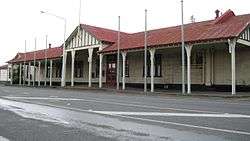
Ashburton lies in the middle of the fertile alluvial Canterbury Plains which permits agricultural activity such as dairying provided irrigation is used.
The Ashburton District Council has a 40% holding in the company that manages the Rangitata Diversion Race.[11] This scheme diverts water from the Rangitata and South Ashburton rivers into a canal that provides irrigation to large parts of the district.
In 2012, Ashburton was noted for having more cooperative companies operating in its district than in any other area of New Zealand, and was subsequently named by the New Zealand Cooperatives Association the "Cooperative Capital of New Zealand". Several of the 40-plus companies are national companies based outside the district, such as Fonterra, Foodstuffs and Silver Fern Farms (meat processing), but many were local cooperatives, such as the Ashburton Trading Society (farm supplies) and Electricity Ashburton (electricity distribution).[12]
Ashburton media includes the Ashburton Guardian daily newspaper, the Mid Canterbury Herald, a free weekly community newspaper owned by Fairfax Media which comes out every Wednesday, The Courier, another free weekly community newspaper owned by the Otago Daily Times, and the Mid Canterbury-focused AshburtonOnline website. Radio Port FM is based in Timaru; Newstalk ZB and Classic Hits ZEFM are re-broadcast from other out-of-town stations.
There is a small recreational airport, Ashburton Aerodrome, serving the town.
Education
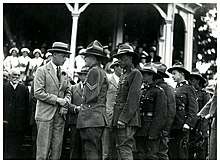
There are seven primary schools, an intermediate school, a secondary school and a composite school in Ashburton. All rolls are as of March 2020.[13]
- Allenton School is a state contributing primary (Year 1–6) school. It has a roll of 392 students.
- Ashburton Borough School is a state full primary (Year 1–8) school. It has a roll of 343 students.
- Ashburton Christian School is a state-integrated evangelical Christian composite (Year 1–13) school. The school opened in February 2009 as a private school, and integrated into the state system in March 2011. It has a roll of 127 students.
- Ashburton College is a state secondary (Year 9–13) school. The school opened in 1965 following the merger of Ashburton High School and Hakatere College. It has a roll of 1205 students.
- Ashburton Intermediate School is a state intermediate (Year 7–8) school. The school opened in 1974. It has a roll of 438 students.
- Ashburton Netherby School is a state contributing primary school. The school opened in 1959. It has a roll of 144 students.
- Fairton School is a state contributing primary school. It has a roll of 33 students.
- Hampstead School is a state contributing primary school. It has a roll of 350 students.
- St Joseph's School is a state-integrated Catholic full primary school. It has a roll of 242 students.
- Tinwald School is a state contributing primary school. It has a roll of 222 students.
- Wakanui School is a state full primary school. It has a roll of 106 students.
Recreation


There is a cinema, swimming pool and two local golf courses. There is a walking track coastwards along the northern side of the river from SH 1. The same track extends west along the river with a mountainbike track. The Ashburton Museum and Art Gallery share one building, which sits on State Highway 1, just outside the centre of town.
The Ashburton Club and Mutual School of Arts (MSA) was founded in 1885. The MSA is a member of the NZ Chartered Clubs Association and is located in the central town. The club itself currently has around 4,000 members on its records.[14]
The Aerodrome located near the town centre and is an active light (GA and Microlight) aviation hub and home of the Mid Canterbury Aero Club (GA) and Ashburton Aviation Pioneers.
The beaches adjacent to Ashburton are steep and shingly with a strong undertow, making them unsafe to swim, but suitable for surf-casting. In part to rectify the limitations imposed by the lack of recreational waterways, Lake Hood was constructed just south-east of Tinwald. The Ashburton, Rakaia, and Rangitata Rivers are suitable for fishing, the Rakaia in particular is renowned worldwide for its salmon fishing. Upper reaches of the Rangitata are frequently kayaked and rafted, reaching Grades 3–4. The Rakaia is known for jet-boating. The Ashburton lakes Lake Heron, Lake Camp and Lake Clearwater are inland. On the road to these lakes are Mount Somers and the Mount Somers walkway.
Mount Hutt is a South Island ski field an hour inland, just past Methven.
Prominent residents
Prominent residents have included the former Prime Minister of New Zealand, Jenny Shipley, international operatic tenor Simon O'Neill, Olympic silver medal cyclist Hayden Roulston and New Zealand television and radio personalities Simon Barnett and Robyn Malcolm.
Rugby union player Chris King was born in Ashburton.
Hugo Friedlander was the second Mayor of Ashburton (1879–1881, 1890–1892 and 1898–1901), but left for Auckland in 1918 due to anti-German feelings caused by WWI.[15]
John Grigg was a local landowner and Member of Parliament in the mid 19th century.
Notes
- "Find my Electorate | Electoral Commission". Elections.org.nz. 25 February 2017. Archived from the original on 8 February 2013. Retrieved 19 March 2017.
- "Council Members". Ashburton District Council. Retrieved 28 April 2020.
- "Subnational Population Estimates: At 30 June 2019". Statistics New Zealand. 22 October 2019. Retrieved 11 January 2020.
- O'Neill, Peter (15 June 2011). "Editorial comment". Ashburton Guardian. Archived from the original on 3 April 2012.
We are close enough to be considered a satellite town.
- Peters, Pam; Collins, Peter; Smith, Adam (2009). Comparative Studies in Australian and New Zealand English: Grammar and Beyond. John Benjamins. p. 57.
- Hendrikx, Jordy. "Preliminary analysis of the 12 June 2006 Canterbury snow storm - NIWA" (PDF). NIWA. Retrieved 25 July 2019.
- "New Zealand's 10 hottest temperatures ever recorded". Stuff. Retrieved 25 July 2019.
- "Ashburton, New Zealand: Climate, Global Warming, and Daylight Charts and Data". Climate-charts.com. Ashburton, New Zealand. Retrieved 19 March 2017.
- "Statistical area 1 dataset for 2018 Census". Statistics New Zealand. March 2020. Ashburton District (063). 2018 Census place summary: Ashburton District
- "Rail Heritage Trust of New Zealand – Ashburton Station and Footbridge". www.railheritage.org.nz. Retrieved 10 February 2016.
- "Rangitata Diversion Race Management Limited (394028) Registered". New Zealand Companies Office. Archived from the original on 24 May 2020.
- "Ashburton Crowned 'Cooperative Capital of NZ'". New Zealand Cooperatives Association (via Scoop.co.nz). 15 July 2012. Retrieved 22 July 2012.
- "New Zealand Schools Directory". New Zealand Ministry of Education. Retrieved 26 April 2020.
- Ashburton Club and M.S.A. ; A century of achievement, 1885–1985. Pg.7
- McCausland, Ray. "Hugo Friedlander". Dictionary of New Zealand Biography. Ministry for Culture and Heritage. Retrieved 1 December 2011.
References
- Reed, A. W. (2002). The Reed Dictionary of New Zealand Place Names. Auckland: Reed Books. ISBN 0-7900-0761-4.
